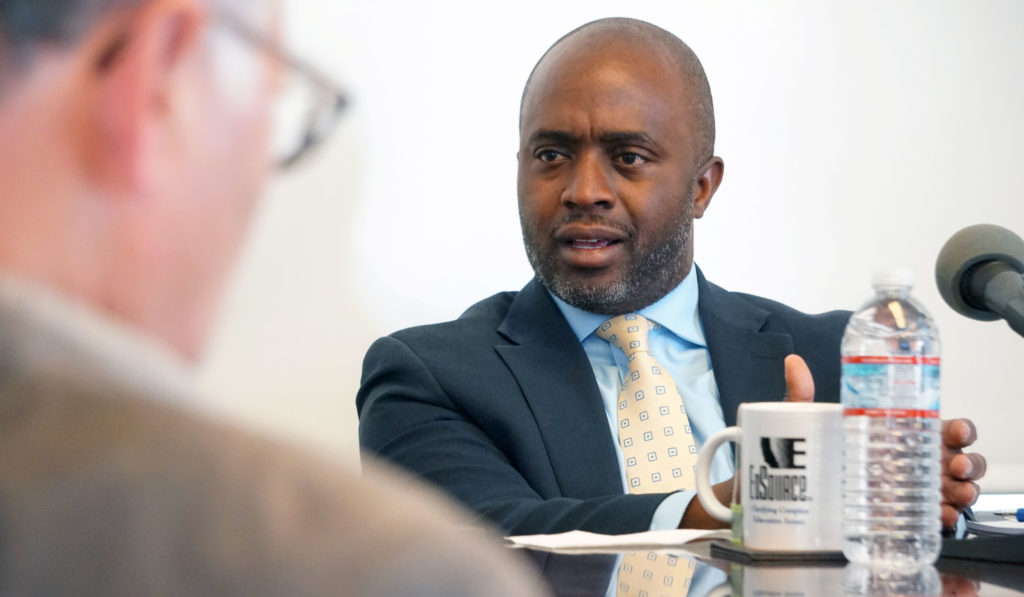State Superintendent of Public Instruction Tony Thurmond
 Photo: Andrew Reed/EdSource
Photo: Andrew Reed/EdSource
State Superintendent of Public Instruction Tony Thurmond
As some states and cities like North Carolina, Arkansas and New York City adopt phonics-based curricula and teaching practices for early literacy, State Superintendent Tony Thurmond said that did not support a particular strategy for the districts of California.
Still, Thurmond acknowledged in an interview with EdSource that teaching explicit phonics “has a clear place” in his drive to have all third-grade students reading by 2026. Thurmond announced the initiative in September and made early literacy a top priority. He assembled a working group of educators and education experts to guide the process.
He acknowledged that California districts may need help evaluating reading programs and the latest literacy research.
Thurmond said the California Department of Education has offered to bring more literacy experts to the department who will help districts interpret any new research and findings about literacy education. He identified this as a “high priority” request in the next state budget.
“We need to build a stronger team of people who have expertise in literacy and can track all of these changes and help districts interpret what these new changes and research mean,” he said.
The Literacy Working Group is still developing its strategy to achieve this goal. Much of the planning depends on the resources made available in the State Budget 2022-23. Thurmond asked schools to join the initiative but does not expect the state to prescribe a program to help them achieve this goal.
Thurmond held a meeting in May to rally districts to commit to its 2026 goal. would not be the case.
“We know there will be different schools of thought on how to achieve third grade reading. I promise you we’re never going to tell you that’s the only way to make it happen,” he said at the meeting. “We are not promoting a one-size-fits-all California approach. It’s been tried before, our state is too big, it’s too diverse.
New York City, on the other hand, requires all elementary schools to adopt one of the phonics-based methods recommended by the Department of Education. kindergarten through second grade programs. Several states, including North Carolina, Mississippi and Arkansas, have policies adopted in recent years following the “science of reading” approach to teaching literacy, which is based on the development of research that learning to read is not a natural process and requires strong emphasis on phonics to teach students to connect letters and pronounce words .
“Phonics will definitely play a key role (in California’s reading and bi-literacy strategy). Districts may use different curricula, they may even use different assessments…” Thurmond told EdSource. “I don’t see anything changing overnight with California being a local control state, but I intend to make sure that we provide the districts with all the resources that could be helpful and the best practices that have made their proofs.
Proponents of the science of reading approach have called on California to follow suit, accusing state education officials of failing to take responsibility for years of falling early reading scores.
Requiring districts to include phonics instruction or only allowing them to use certain programs would require legislation, Thurmond said, and there are currently no bills to do so.
“We are looking at these issues and developing a better strategy for the state to address literacy, and that involves many people and many entities finding a way to help individual districts,” he said. -he declares.
Thurmond supports Gov. Gavin Newsom’s five-year, $500 million proposal to train and hire literacy coaches and reading specialists and a $200 million grant program for schools to create or expand their multilingual schools and purchase culturally relevant texts for teaching reading.
Both are included in the governor’s proposed state budget for 2022-23, which will be finalized by mid-June.
Thurmond said the proposed funding for specialists and coaches is crucial, as he has heard current district specialists and coaches have been “pushed into classroom teaching positions” amid the national shortage of staff. ‘teachers.
In addition to the governor’s proposal, lawmakers are considering three bills for the programs recommended by the task force. Assembly Bill 2465 create grant programs to provide library cards to every student in public schools, fund programs that include home visits to engage families in teaching their students literacy, and fund the development and certification of 500 new bilingual educators to support biliteracy in schools. SB 952 would also support biliteracy in schools by providing grants to school districts, county offices of education, and some charter schools to create dual-language immersion programs.
AB 2498 would establish a three-year pilot project to expand Freedom Schools, which are Afrocentric summer literacy and learning loss mitigation programs.
For more reports like this, click here to sign up for EdSource’s free daily email about the latest developments in education.

